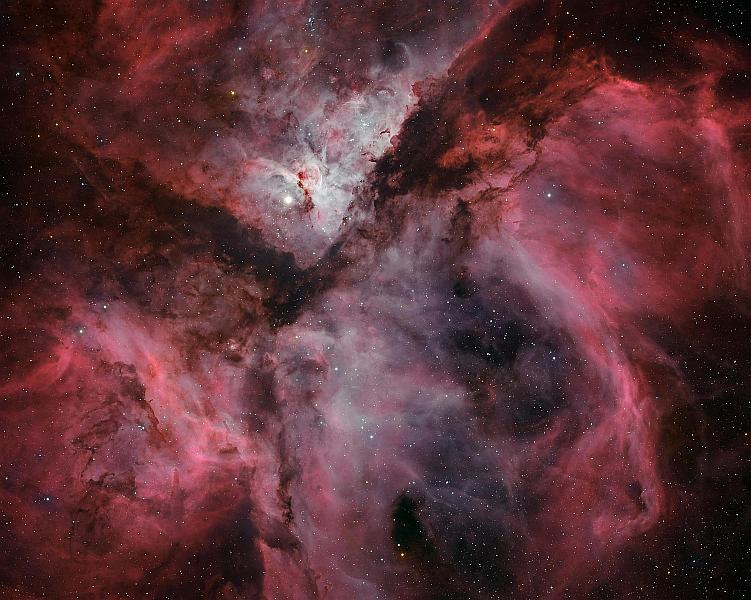Carina Nebula |
 |
| South of the celestial equator (simply the
projection of the Earth's equator into space) lies the
constellation Carina. Carina is a constellation named for less
mythical and slightly more modern objects, as the southern
constellations happened to be named during the age of
exploration. Carina, in fact, is named after the keel of a ship.
It was originally part of a much larger constellation, Argo
Navis (the ship Argo), that was then broken up into three
smaller constellations: Puppis (the poop deck) and Vela (the
sails), along with the aforementioned Carina. This constellation
starts to be visible from southern latitudes of the northern
hemisphere. I've personally seen Canopus, which is the brightest
star of this constellation, during my visits to the Philippines.
As one heads further south (and south of the equator,
especially), this constellation will ride higher and higher in
the sky. Within the boundaries of Carina lies a nebula catalogued as NGC 3372 which was discovered by Nicolas-Louis de Lacaille in 1752 from the Cape of Good Hope. This nebula is also known as the Eta Carinae Nebula or the Carina Nebula. This is a large, complex area of bright and dark nebulosity located in the Carina–Sagittarius Arm of the Milky Way galaxy. The nebula lies at an estimated distance of approximately 8,500 light-years (2,600 pc) from Earth. Classified as an emission nebula, the Carina Nebula is another star birthplace and is glowing primarily from the ionization of hydrogen within its regions from intense ultraviolet radiation from the young and/or massive stars within its confines. Among the many open clusters within this nebula are Trumplers 14 and 16. Trumpler 14 is a very young (celestially speaking) star clusters having stars about a half million years old (in contrast to the Sun, which is about 4.5 billion years old). One object of note is the star Eta Carinae, the brightest star in this image (slightly above and to the left of center). It is currently about a 4th magnitude star from our perspective, but in 1837 it became brighter than Rigel and briefly became the second brightest star in the sky in 1843 during a period called the Great Eruption. Eta Carinae is now known to be a massive double star, both of which are many times the mass of the sun. The larger of the two is about 150-250 times the mass of the sun, but has already lost 30 solar masses to date due to massive stellar winds. The smaller of the two is about 30-80 times the mass of the Sun. The primary is expected to go Supernova in the astronomically near future. Both stars are hidden from view by the Homonculus Nebula <link to Wikipedia here>, which is believed to be material blown off by the primary star during the Great Eruption. The Carina Nebula is one of the largest diffuse nebulae in our skies. It is four times larger and even brighter than the famous Orion Nebula! It is not as famous as the Orion nebula because of its location in the southern sky. In many respects it exceeds the Orion Nebula with its impressive statistics: not only does it contain many massive stars, it also contains many young star clusters and dark nebulae. If it is as close to us as the Orion Nebula (which is about 1500 light-years distant), it would dominate that region of the sky! Somewhat frustrating for me is that the front yard of the home I grew up in the Philippines faced South. I could have had a view of this nebula (granted, I was in a light-polluted urban center) growing up! This image was assembled from sample data taken by award-winning astrophotographer Martin Pugh, host of a remote observatory in New South Wales, Australia. |
| Constellation: Carina |
| When Visible: December - April |
| DDistance: 8,500 Light-years |
| Dates:
February 2018 |
| Location: Yass, New South Wales, Australia |
| Exposure Details: Hydrogen-Alpha: 6 x 30 Minutes binned 1x1 R: 6 x 20 Minutes G: 6 x 20 Minutes B: 6 x 20 Minutes |
| Equipment Used:
Optics: Astro-Physics 305 mm f/3.8 Riccardi-Honders Astrograph Mount: Software Bisque Paramount MEII Camera: SBIG STXL-16200 camera |
| Acquisition Software : TheSkyX |
| Processing Software: MaximDL, Photoshop CS5, Noel Carboni Actions, AviStack |
